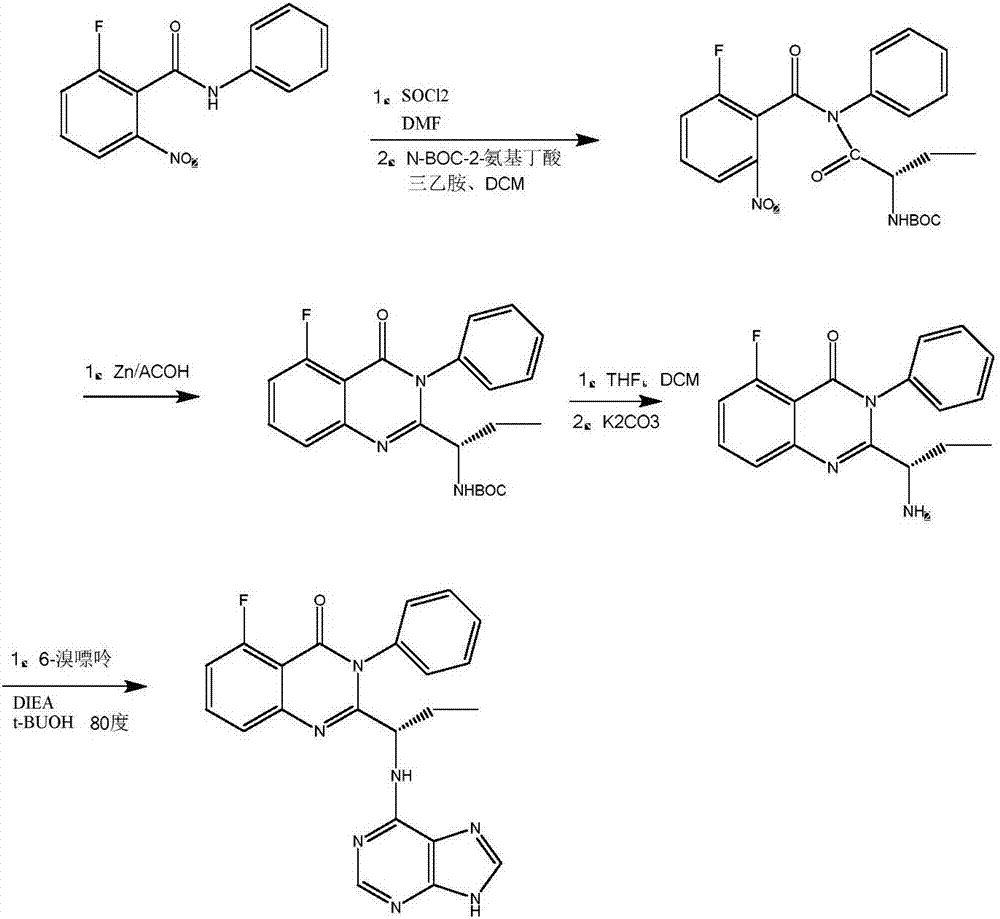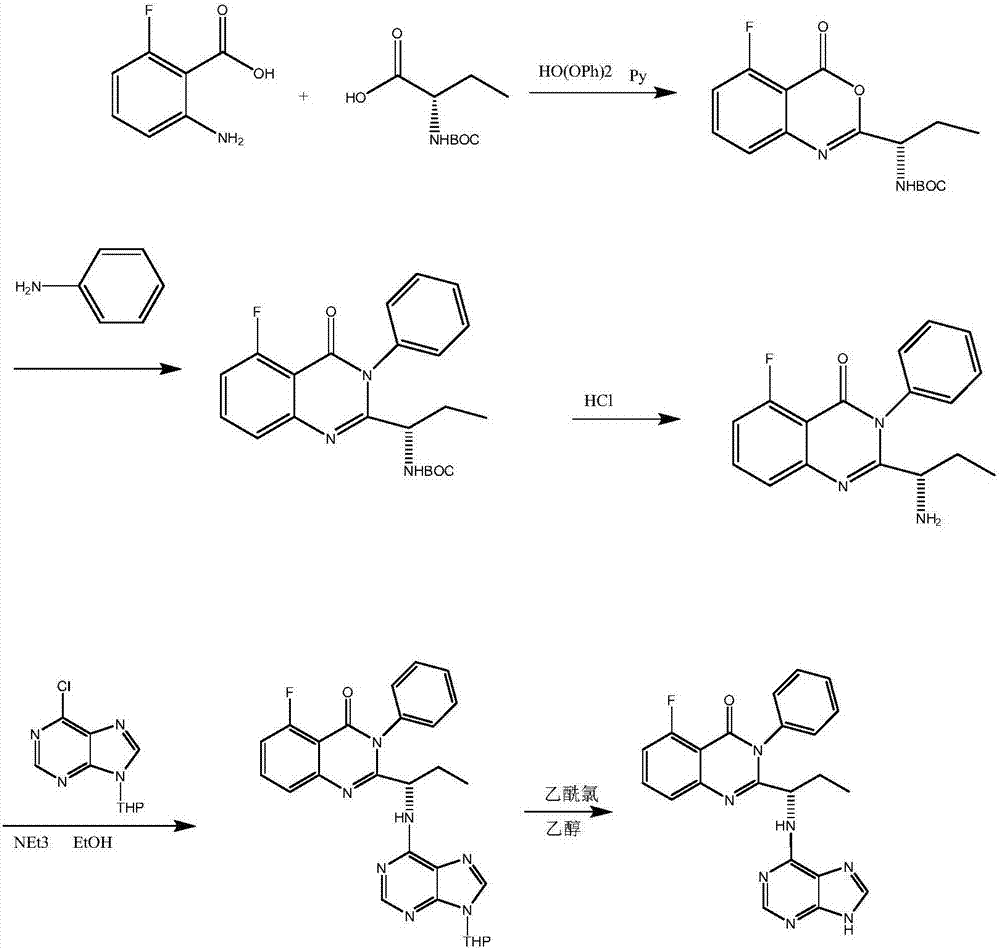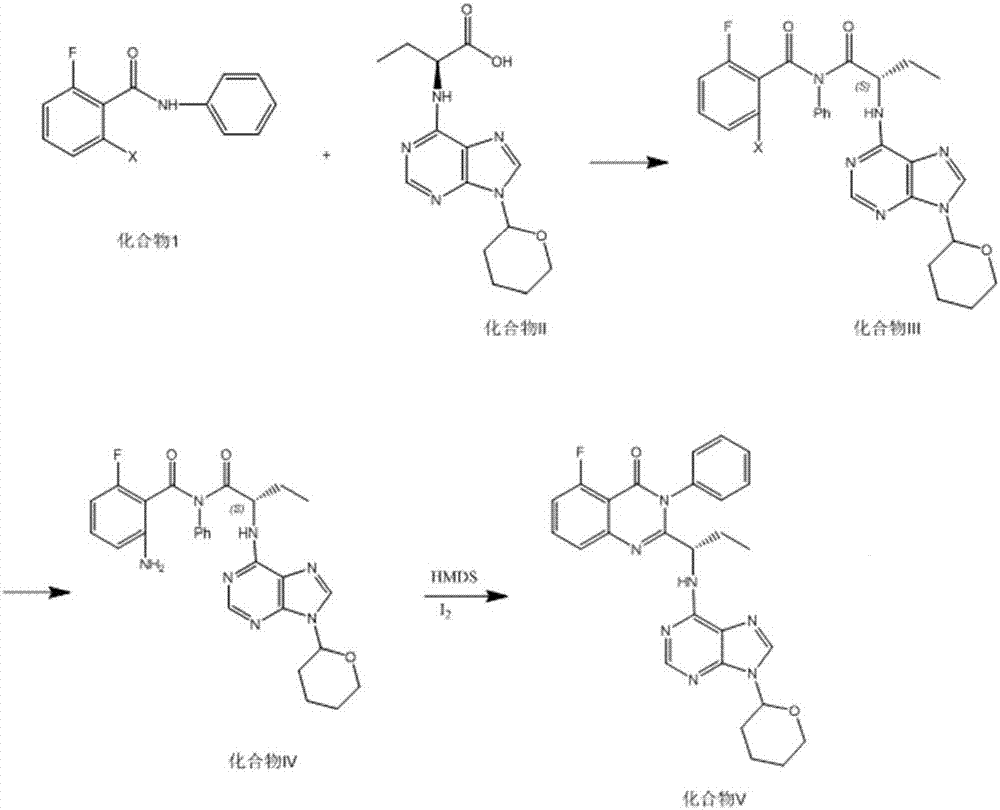Preparation method of Idelalisib and intermediate thereof
A technology of idelaris and intermediates, applied in the direction of organic chemistry, can solve the problems of unfavorable environment, achieve the effect of reducing solid waste, avoiding genotoxic raw materials, improving safety and product yield
- Summary
- Abstract
- Description
- Claims
- Application Information
AI Technical Summary
Problems solved by technology
Method used
Image
Examples
preparation example Construction
[0037] 3) The preparation of compound V is a ring-closing reaction, and the solvents are dichloromethane, chloroform, tetrahydrofuran, DME (ethylene glycol dimethyl ether), etc. Compound IV: solvent (mass ratio) = 1:5-1:10. The reaction raw materials are compound IV, iodine and HMDS (hexamethylsilazane), and the ratio of the reaction raw materials is compound IV: iodine: HMDS=1:0.8:2~1:1.2:5. The reaction temperature is 35~80°C. The reaction time is 24~48h. The reaction product can be purified by crystallization from isopropanol.
[0038] 4) Like the method in WO2015095601, hydrochloric acid can be used to depyran and sodium bicarbonate to adjust alkali to obtain the final product Idelalis.
Embodiment 1
[0040] The preparation of embodiment 1 chlorinated compound III:
[0041] In the flask, install N2 protection, install a thermometer, constant pressure dropping funnel and magnetic stirring. At room temperature, add 8 grams of phosphorus oxychloride to the reaction bottle, slowly add 30 g of triethylamine dropwise, keep the temperature at 5-40°C, after the drop is complete, react at 30-40°C for 0.5 hours, then add compound I in batches (X=Cl) 12.5g, stirred at 20-40°C for 3-4 hours. Concentrate under reduced pressure to remove part of excess hydrogen chloride. Add DME 30g and stir evenly, add to the constant pressure dropping funnel, set aside.
[0042] In another four-necked bottle, install N2 protection, a thermometer and the constant pressure dropping funnel of the above-mentioned acylated material. 15 g of compound II, 12 g of triethylamine, and 60 g of DME were added. The acylate in the above-mentioned pressure dropping funnel is added dropwise at a controlled tempera...
Embodiment 2
[0044] The preparation of embodiment 2 brominated compound III:
[0045]In the flask, install N2 protection, install a thermometer, constant pressure dropping funnel and magnetic stirring. At room temperature, add 10 g of phosphorus oxychloride to the reaction bottle, slowly add 25 g of triethylamine dropwise, keep the temperature at 5-40°C, after the drop is complete, react at 30-40°C for 0.5 hours, then add compound I in batches (X=Br) 15g, stirred at 20-40°C for 3-4 hours. Concentrate under reduced pressure to remove part of excess hydrogen chloride. Add DME 30g and stir evenly, add to the constant pressure dropping funnel, set aside.
[0046] In another four-necked bottle, install N2 protection, a thermometer and the constant pressure dropping funnel of the above-mentioned acylated material. 15.3 g of compound II, 10 g of triethylamine, and 60 g of DME were added. The acylate in the above-mentioned pressure dropping funnel is added dropwise at a controlled temperature ...
PUM
 Login to View More
Login to View More Abstract
Description
Claims
Application Information
 Login to View More
Login to View More - R&D
- Intellectual Property
- Life Sciences
- Materials
- Tech Scout
- Unparalleled Data Quality
- Higher Quality Content
- 60% Fewer Hallucinations
Browse by: Latest US Patents, China's latest patents, Technical Efficacy Thesaurus, Application Domain, Technology Topic, Popular Technical Reports.
© 2025 PatSnap. All rights reserved.Legal|Privacy policy|Modern Slavery Act Transparency Statement|Sitemap|About US| Contact US: help@patsnap.com



